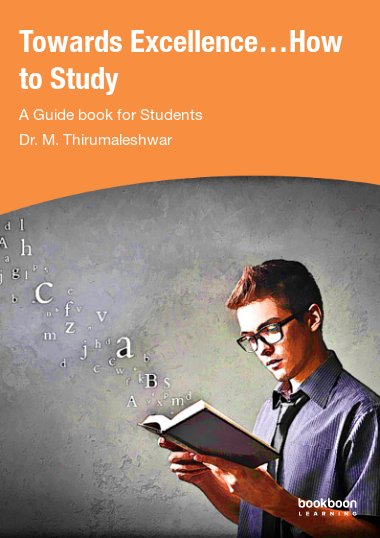This booklet for students is the first of the three books in the “Towards Excellence…” series. These books were first authored and published by me with generous financial help from the Director, St. Joseph Engineering College, Vamanjoor, Mangalore, India, and distributed for free to schools, Pre-University, Degree and Professional colleges in Mangalore Dioces area. The books were received very enthusiastically by students (and parents and teachers too) and there was great demand/suggestion to put them on the Internet so that a larger number of readers can take benefit of these books. So, the first book for students, viz. “Towards Excellence…How to study” is now being put on the Internet, by courtesy of Bookboon. Other two books, viz. “Towards Excellence…How to teach” and “Towards Excellence…Seminars, GD’s and Personal Interviews” will follow very soon.
This booklet is the outcome of the lectures delivered by the author over the years to First year Engineering students to motivate them to study as they entered the college.
It was generally observed that nearly 50% of the First year students failed in their exams, even though they were basically intelligent and gained entry to engineering courses after writing Competitive Entrance Test. So, these lectures analyzed the psychology of the students, their dreams and fears, their worries, pressures and anxieties; and, correct attitudes in attending the lectures in the classes, proper methods of studying, preparing for the exams and techniques of writing the exams etc were explained to them. Feedback from the students about these lectures was consistently ‘excellent’ and the students freely expressed as to how greatly they were benefited from these lectures. It was felt that a larger cross-section of students would get benefited if the matter contained in the lectures was brought out in a book form, and that was the motivation for this work.
The book is divided into sections: after giving an introduction in the first two sections, (i.e. in sections 0 and 1), students are warned about the possible pit falls and the reasons for these set-backs, in the next two sections. In section 4, we quote Greek Philosopher Socrates to exhort the students to excel: “…by making sure that you take every step in that direction”, and in sections 5 and 6, we analyze the pressures faced by the students as they join the college. Various fears and the academic and personal difficulties experienced by the students, are enumerated in section 7. In section 8, we consider the very important topic of dealing with ‘stress’ generated in the students and the methods of overcoming the same. Section 9 is the most important section of this book. This section explains the techniques to sharpen the mind and the various ways of gathering and consolidation of knowledge; also, ‘memory techniques’ and different types of ‘mnemonics’ to help students remember things are described. Further, topics such as ‘exam fear’ and the ways of getting over it, preparing for exam, exam strategies, time management and effective methods of writing the exam are explained. Section 10 summarizes the matter described earlier and states succinctly the ‘seven steps’ to success. Finally, in section 11, inspirational quotations from Saints and great personalities in history are given, which should certainly motivate the students to become good human beings, in addition to excelling in academics.
Section 12 gives references for further reading.
Three important Appendixes have been added in section 13: Appendix-I gives a few inspirational quotes to ponder over; In Appendix-II, excerpts from ‘110 Rules of Civility’ by George Washington, the First American President, are given. It is said that George Washington copied these Rules in his own hand when he was a student, and that these Rules had the earliest and most profound impact on his character. In Appendix-III is given excerpts from the famous letter written by Abraham Lincoln to his son’s teacher, saying how the boy should be educated. I am sure that these Appendixes will enhance the value of the book, and will be appreciated by the readers.
Thus, even though the lectures were originally directed towards engineering students, this booklet should be useful to all students, since the analysis of difficulties, and hints towards gathering of knowledge, methods of study, exam preparation, writing the exam etc. are common to all branches of study.
Acknowledgements: Firstly, I would like to thank all my students who motivated me to give these lectures, encouraged me by their love, support and positive feedback.
My cousin, Mr. A.R. Bhat, Retd. Teacher, Ganapathy P.U.C. College, Mangalore, greatly enthused me by his words of advice and encouragement; I express my sincere gratitude to him.
I would like to thank Fr. Valerian D’souza, former Director, St. Joseph Engineering College, Mangalore, for his continued encouragement and for supporting the publication of this book.
I express my appreciation to Kala, my wife, for always being sympathetic and supportive in my academic efforts.
Finally, my sincere thanks to Ms. Karin Jakobsen, Ms. Sophie Tergeist and their team at Bookboon.com for their excellent editorial support and cooperation.

